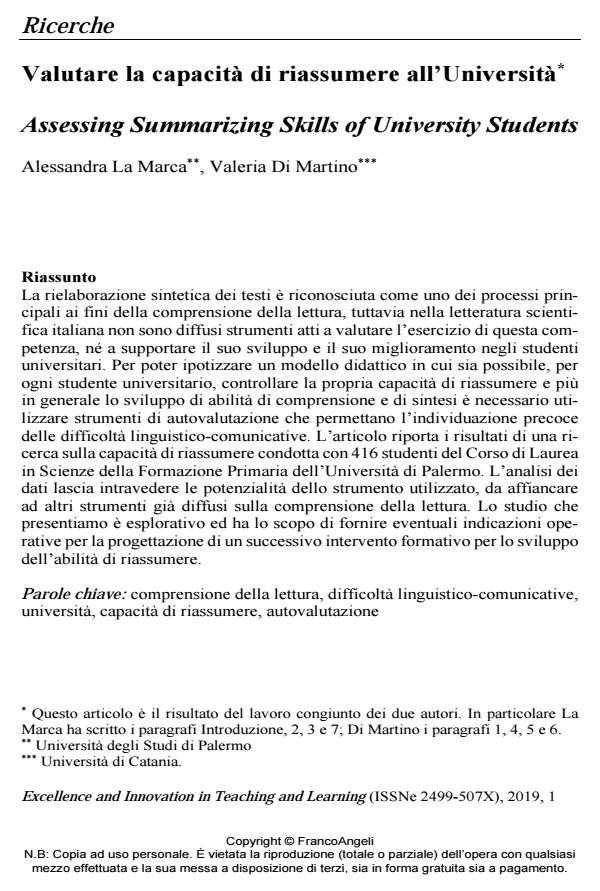Assessing Summarizing Skills of University Students
Journal title EXCELLENCE AND INNOVATION IN LEARNING AND TEACHING
Author/s Alessandra la Marca, Valeria Di Martino
Publishing Year 2019 Issue 2019/1 Language Italian
Pages 18 P. 5-22 File size 322 KB
DOI 10.3280/EXI2019-001001
DOI is like a bar code for intellectual property: to have more infomation
click here
Below, you can see the article first page
If you want to buy this article in PDF format, you can do it, following the instructions to buy download credits

FrancoAngeli is member of Publishers International Linking Association, Inc (PILA), a not-for-profit association which run the CrossRef service enabling links to and from online scholarly content.
The short re-elaboration of a text is one of the main processes for reading comprehension. However, in the Italian scientific literature, tools are not widespread to measure the practice of this competence, nor to support its development and improvement in university students. In order to hypothesize a didactic model to help university students monitor their own capacity of reassuming and the development of comprehension and summarizing, it is fundamental to use self-assessment tools that allow the early identification of linguistic-communicative difficulties. This paper reports the results of a study on capacity of reassuming. The research is carried out with 416 students attending to Primary Education Degree Course at the University of Palermo. The data analysis reveals the potentially of the tool used, which may support other existing tools for reading comprehension. It is an exploratory research and it aims to provide possible indications for a subsequent training intervention for the development of summarizing ability.
Keywords: Reading comprehension, linguistic-communicative difficulties, university, summarizing ability, self-assessment
- Anderson, V., Hidi, S. (1988). Teaching students to summarize. Educational Leadership, 46 (4), 26-28.
- Benvenuto, G. (1987). Insegnare a riassumere. Proposte per un itinerario didattico di prove di riassunto. Torino: Loescher.
- Berners-Lee, T., Hendler, J., Lassila, O. (2001). The semantic web. Scientific American, 284, 34-43.
- Brown, A. L., Day, J. D. (1983). Macrorules for summarizing texts: The development of expertise. Journal of verbal learning and verbal behavior, 22(1), 1-14.
- Brown, A. L., Day, J. D., Jones, R. S. (1983). The development of plans for summarizing texts. Child development, 968-979. DOI: 10.2307/1129901.
- Corno, D. (1987). Lingua scritta: scrivere e insegnare a scrivere. Paravia.
- Devescovi, A., Miceli M. (1979). Sul riassunto. In Parisi D. (a cura di). Per una educazione linguistica razionale. Bologna: il Mulino.
- Di Martino, V., La Marca, A. (2019). Assessing Metacomprehension and Metacognitive Reading Strategies. IOSR Journal of Research & Method in Education, 9 (2), 38-48. DOI: 10.9790/1959-0902033848
- Friend, R. (2001). Effects of strategy instruction on summary writing of college students. Contemporary Educational Psychology, 26(1), 3-24.
- Garnham, A., Oakhill, J. (1996). The mental models theory of language comprehension. Models of understanding text, 313-339.
- Gülbay, E., La Marca, A., Bono, C. (2018). Espressione scritta per lo sviluppo della creatività e della capacità critica in Università. Formazione e Insegnamento, 16 (1), 251-269.
- Johnson-Laird, P. N. (1983). Mental models: Towards a cognitive science of language, inference, and consciousness (No. 6). Harvard University Press. DOI: 10.2307/414498
- Kintsch, W., Van Dijk, T. A. (1978). Toward a model text comprehension and production. Psychological Review, 85, 363-394.
- La Marca, A., Di Martino, V. (2019). Il Summarizing Test U: uno strumento per lo sviluppo dei talenti all’Università. Formazione e Insegnamento, in press.
- La Marca, A., Gulbay, E. (2018). Didattica universitaria e soft skills. Lecce: Pensa Multimedia.
- Levorato, M. C. (1988). Racconti, storie e narrazioni: i processi di comprensione dei testi. Bologna: il Mulino.
- Levorato, M. C. (2000). Le emozioni nella lettura. Bologna: il Mulino.
- Lumbelli, L. (1989). Fenomenologia dello scrivere chiaro. Roma: Editori riuniti.
- Lumbelli, L. (2009). La comprensione come problema. Il punto di vista cognitivo. Bari: Laterza.
- Menichetti, L. (2018). Valutare la capacità di riassumere. Il Summarizing Test, uno strumento per la scuola primaria. Journal of Educational, Cultural and Psychological Studies (ECPS Journal), (18), 369-396.
- Pečjak, S., Pirc, T. (2018). Developing summarizing skills in 4th grade students: Intervention programme effects. International Electronic Journal of Elementary Education, 10 (5), 571-581.
- Rigo, R. (2005). Didattica delle abilità linguistiche. Percorsi di progettazione e di formazione insegnanti. Roma: Armando Editore.
- Trinchero, R., Rabasto, D. (2019). Mixed Methods nella ricerca educativa. Milano: Mondadori.
- Van Dijk, T. A., Kintsch, W. (1983). Strategies of discourse comprehension. New York: Academic Press.
- Werlich, E. (1975). Typologie der Texte: Entwurf e. textlinguist. Modells z. Grundlegung e. Textgrammatik. Heidelberg: Quelle Meyer.
- Winograd, P. N. (1984). Strategic difficulties in summarizing texts. Reading Research Quarterly, 404-425. DOI: 10.2307/747913
- Zanniello, G. (2016). La didattica tra storia e ricerca. Roma: Armando Editore.
Alessandra la Marca, Valeria Di Martino, Valutare la capacità di riassumere all’Università in "EXCELLENCE AND INNOVATION IN LEARNING AND TEACHING" 1/2019, pp 5-22, DOI: 10.3280/EXI2019-001001